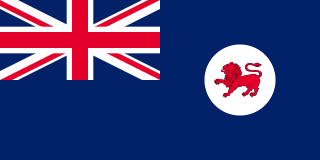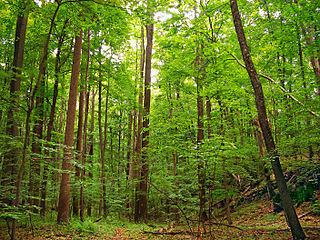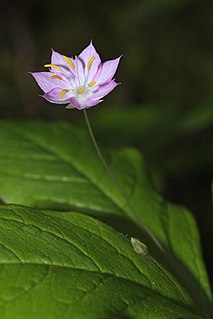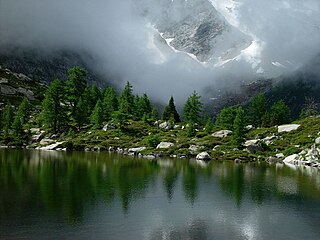Prasophyllum amoenum, commonly known as the dainty leek orchid or Snug leek orchid, is a species of orchid endemic to Tasmania. It has a single tubular, green leaf with a purplish base and between five and twelve light green, dark brown and white flowers. In 2007, the entire population was estimated to be about 600 plants.
Prasophyllum campestre, commonly known as the sandplain leek orchid, or inland leek orchid, is a species of orchid endemic to eastern Australia. It has a single tubular, yellowish-green leaf and up to twenty greenish, strongly scented flowers with red, purplish, brown or white marks. It grows in the drier parts of Queensland, New South Wales and Victoria.

Prasophyllum wilkinsoniorum is a species of orchid endemic to New South Wales. It has a single tubular, bright green leaf and up to forty five scented, dark greenish-brown to brownish-red flowers with a green to pinkish labellum. It grows in grassy places in a restricted area on the Southern Tablelands.

Prasophyllum caricetum, commonly known as the Cathcart leek orchid, is a species of orchid endemic to a small area of southern New South Wales. It has a single tubular, bright green leaf and up to twenty five green, white and purplish flowers crowded on the flowering stem. It grows in montane swamps near Cathcart.
Prasophyllum favonium, commonly known as the western leek orchid, is a species of orchid endemic to Tasmania. It has a single tubular leaf with a reddish base and between five and fifteen brownish flowers with a dark purple labellum. In 2000, the entire population was estimated to be less than forty mature plants in a very small area.
Prasophyllum innubum, commonly known as the Brandy Mary's leek orchid, is a species of orchid endemic to a small region of New South Wales. It has a single tubular, bright green leaf and up to twenty brownish-green, white and purplish flowers. It is a very rare orchid with only about four hundred plants known.
Prasophyllum keltonii, commonly known as Kelton's leek orchid, is a species of orchid endemic to a small region of New South Wales. It has a single tubular, bright green leaf and up to twenty two scented, green, brownish-red or purplish flowers. It is a very rare orchid with only a few hundred plants known.
Prasophyllum milfordense is a species of orchid endemic to Tasmania. It has a single tubular, dark green leaf and up to thirty greenish-brown, white and purplish flowers. It is a very rare orchid, only found in a single location with a population of around 240 plants.
Prasophyllum olidum, commonly known as the pungent leek orchid is a species of orchid endemic to Tasmania. It has a single tubular, green to yellowish-green leaf and up to thirty bright green to brownish-green flowers. It is a very rare orchid, only found in a single location with a population which fluctuates from three to two hundred flowering plants.

Prasophyllum solstitium is a species of orchid endemic to the Northern Tablelands of New South Wales. It has a single tubular, bright green leaf and up to thirty five greenish-pink to purplish-red flowers crowded on the flowering stem. It grows in grassland on heavy basalt soil.
Prasophyllum stellatum, commonly known as the Ben Lomond leek orchid, is a species of orchid endemic to Tasmania. It has a single tubular, dark green leaf and up to twenty greenish-brown to brownish flowers with a white labellum. It is only known from two disjunct populations, at Ben Lomond and near Deloraine.
Prasophyllum truncatum, commonly known as the truncate leek orchid, is a species of orchid endemic to Tasmania. It has a single tubular, dark green leaf and up to twenty whitish flowers with purplish and greenish-brown markings. It is a late-flowering leek orchid and its flowering is stimulated by earlier fire.

Prasophyllum tunbridgense, commonly known as the Tunbridge leek orchid, is a species of orchid endemic to Tasmania. It has a single tubular, bright green leaf and up to twenty five relatively large, green to light greenish-brown flowers with white petals and a large white labellum.
Prasophyllum stygium, commonly known as the elfin leek orchid, is a species of orchid endemic to Victoria. It has a single tube-shaped leaf and up to twenty greenish-brown flowers with a white labellum. It is a recently described plant, previously included with P. fitzgeraldii, but distinguished from that species by its greenish-brown flowers with their white labellum and narrower brown callus. It is only known from a single population of about thirty plants.
Prasophyllum collinum is a species of orchid endemic to South Australia. It has a single tubular leaf and up to thirty lemon-scented, greenish brown and white flowers. It is only known from the Eyre Peninsula where it grows in sparse woodland.

Prasophyllum basalticum is a species of orchid endemic to New South Wales. It has a single tubular, dark green leaf and up to fifteen scented, greenish-brown to brownish-red flowers with a white and green labellum. It grows in grassy woodland on the Northern Tablelands.
Prasophyllum graniticola is a species of orchid endemic to New South Wales. It has a single tubular, shiny dark green leaf and up to twenty five scented, greenish to brownish and white flowers. It is only known from two populations on the Northern Tablelands.
Prasophyllum holzingeri is a species of orchid endemic to New South Wales. It has a single tubular, shiny dark green leaf and up to fifteen unscented, greenish to brownish pink and white flowers. It is only known from a few populations in the Barrington Tops area.
Prasophyllum pilligaense is a species of orchid endemic to New South Wales. It has a single tubular, shiny dark green leaf and up to thirty scented greenish brown to brownish and white flowers. It is only known from a few populations in the Coonabarabran district.













